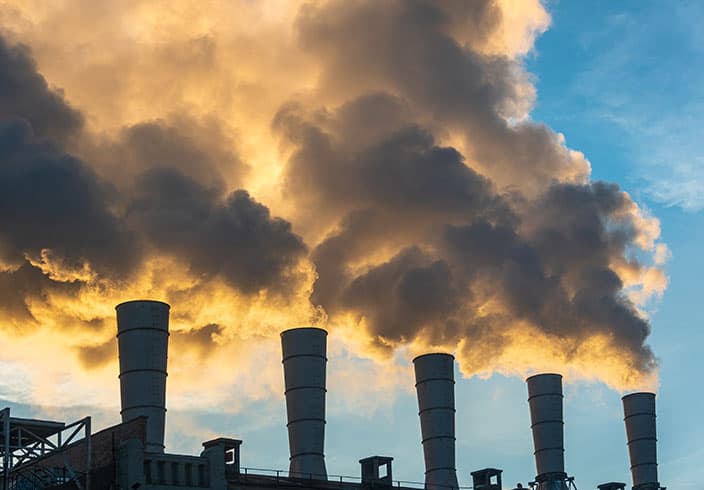Highly digitized and connected industrial surroundings are rapidly advancing all over the world. However, in order to meet climate targets, a heat transition from fossil to renewable sources is essential. A key priority in this context is the decarbonization of process heat and steam in energy-intensive industries.
Process heat in industrial settings
It’s a well-known fact that most industrial processes have a high demand for heat. The so-called process heat needed to melt, forge, burn or dry glass, metal, cement or paper accounts for a large part of the total energy consumed by industrial companies. This is hardly surprising, given that some industrial processes require temperatures of up to 3,000 °C.
Process heat: How to reduce CO2 emissions
It is alarming that to date, only a small percentage of the energy required to provide heat is covered by renewable energies. Electricity in general is still underrepresented and far from being an emission-free energy source in today’s electricity mix.
In order to change this and also to force the currently still existing strong dependence on fossil energy sources such as oil or natural gas – and thus also on their suppliers – initiatives to decarbonize process heat are attributed great potential. In this context, the focus of optimization lies primarily on the electrification of industrial processes and thus the switch to electricity-based processes.
So, how can the much needed decarbonization of the industrial sector succeed in practice? “The decisive factor is efficient energy management – and the best way to achieve this is intelligent electrification. Plant operators benefit from more flexibility in production, lifecycle optimization and higher performance. This puts the decarbonization of the industrial sector within reach – through green power and extensive opportunities to improve energy efficiency,” writes German trade magazine Digital-Process-Industry.
With a view to achieving the goal of climate-neutral process heat, the trade magazine has identified three levers for reducing CO2 emissions: “Firstly, it is a question of introducing more flexibility into energy use, for example through the use of storage solutions and virtual power plants. Secondly, we need to digitize operational processes so that energy can really be used efficiently. This can be achieved through the use of IoT devices, sensors and software. And thirdly, we need smart electrification across all operational processes. Of these three levers, the third has the highest decarbonization potential and can benefit considerably from the first two.”
Electrifying industrial heat supply
“The electrification of processes and applications is the prerequisite for a successful energy transition,” writes Fraunhofer Institute in its impulse paper “Process heat for a climate-neutral industry”. This is precisely where thermal energy storage solutions such as ENERGYNEST’s ThermalBattery™ provide support. The intelligent storage solution, which can be easily integrated into many industrial environments, makes it possible to purchase regeneratively produced electricity on the market at favorable times, store it as heat and release it again at a later time as part of industrial processes in the form of heat or steam. With the help of electrically operated boilers, companies can thus electrify their process heat.
Sustainable and climate-neutral process heat
Next to the electrification of industrial processes, waste heat recovery is also an important pillar in a successful energy transition. The German Energy Agency (DENA) writes: “The use of industrial waste heat holds outstanding energy efficiency potential.” According to DENA, German industry spends 1,670 petajoules or 460 terawatt hours of energy annually to generate heat for production and processing operations. However, a high proportion of this is lost as unused waste heat. “This energy efficiency potential must be leveraged for the benefit of international competitiveness and as a contribution to the energy transition,” says DENA. Here, too, thermal energy storage solutions such as ThermalBattery™ score points.
ThermalBattery™: Utilizing waste heat creates independence
Once installed, the ThermalBattery™ captures excess heat from industrial processes and stores it to make it available at a later date. By connecting the ThermalBattery™ to industrial plants, heat that would otherwise be wasted can be recovered and converted into process heat, steam, electricity or compressed air. This can not only significantly improve plant efficiency and decarbonization effectiveness. It can also ensure the reliability of supply, which is often the focus of debate in relation to renewable energy. ENERGYNEST is convinced that the storage and reuse of waste heat from industrial processes has a massive impact on global energy efficiency.
Measures for the decarbonization of industrial processes
In order to drive forward measures to decarbonize industrial processes in the future, there is no way around energy storage solutions. Companies can replace fossil fuels with renewable energies and at the same time guarantee a reliable and stable supply for their processes. For industry, ThermalBattery™ in particular comes with another key advantage: the solution is modular and, if desired, completely OPEX-based with no acquisition costs. This makes heat supply significantly more flexible and paves the way for a decarbonized industrial landscape.
Are you interested in ENERGYNEST, or have any questions regarding our thermal energy storage solutions or our applications for your specific industry?
Don’t hesitate to drop us a line.



